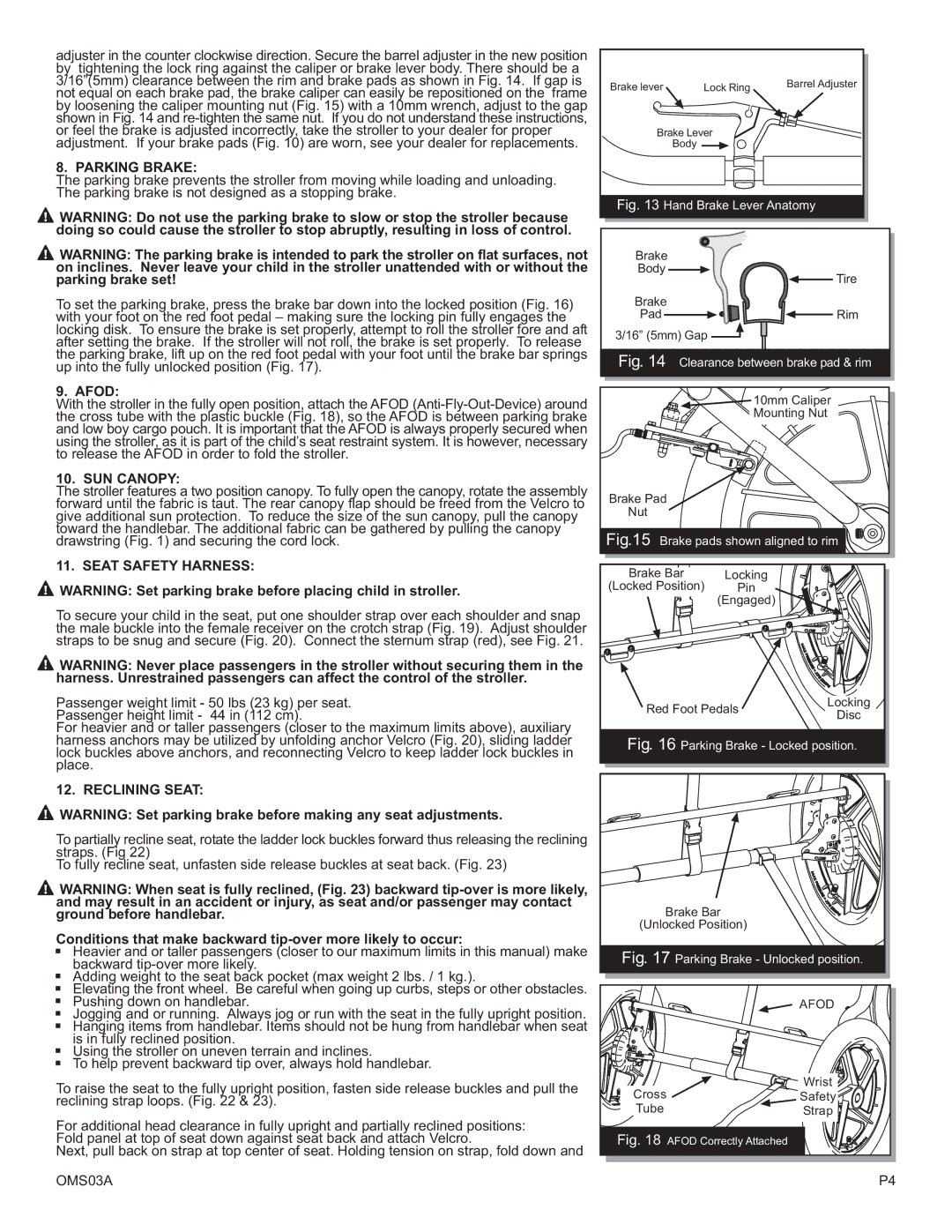
adjuster in the counter clockwise direction. Secure the barrel adjuster in the new position by tightening the lock ring against the caliper or brake lever body. There should be a 3/16”(5mm) clearance between the rim and brake pads as shown in Fig. 14. If gap is not equal on each brake pad, the brake caliper can easily be repositioned on the frame by loosening the caliper mounting nut (Fig. 15) with a 10mm wrench, adjust to the gap shown in Fig. 14 and
8. PARKING BRAKE:
The parking brake prevents the stroller from moving while loading and unloading. The parking brake is not designed as a stopping brake.
WARNING: Do not use the parking brake to slow or stop the stroller because doing so could cause the stroller to stop abruptly, resulting in loss of control.
WARNING: The parking brake is intended to park the stroller on flat surfaces, not on inclines. Never leave your child in the stroller unattended with or without the parking brake set!
To set the parking brake, press the brake bar down into the locked position (Fig. 16) with your foot on the red foot pedal – making sure the locking pin fully engages the locking disk. To ensure the brake is set properly, attempt to roll the stroller fore and aft after setting the brake. If the stroller will not roll, the brake is set properly. To release the parking brake, lift up on the red foot pedal with your foot until the brake bar springs up into the fully unlocked position (Fig. 17).
9. AFOD:
With the stroller in the fully open position, attach the AFOD
10. SUN CANOPY:
The stroller features a two position canopy. To fully open the canopy, rotate the assembly forward until the fabric is taut. The rear canopy flap should be freed from the Velcro to give additional sun protection. To reduce the size of the sun canopy, pull the canopy toward the handlebar. The additional fabric can be gathered by pulling the canopy drawstring (Fig. 1) and securing the cord lock.
11. SEAT SAFETY HARNESS:
![]() WARNING: Set parking brake before placing child in stroller.
WARNING: Set parking brake before placing child in stroller.
To secure your child in the seat, put one shoulder strap over each shoulder and snap the male buckle into the female receiver on the crotch strap (Fig. 19). Adjust shoulder straps to be snug and secure (Fig. 20). Connect the sternum strap (red), see Fig. 21.
WARNING: Never place passengers in the stroller without securing them in the harness. Unrestrained passengers can affect the control of the stroller.
Passenger weight limit - 50 lbs (23 kg) per seat. Passenger height limit - 44 in (112 cm).
For heavier and or taller passengers (closer to the maximum limits above), auxiliary harness anchors may be utilized by unfolding anchor Velcro (Fig. 20), sliding ladder lock buckles above anchors, and reconnecting Velcro to keep ladder lock buckles in place.
12. RECLINING SEAT:
![]() WARNING: Set parking brake before making any seat adjustments.
WARNING: Set parking brake before making any seat adjustments.
To partially recline seat, rotate the ladder lock buckles forward thus releasing the reclining straps. (Fig 22)
To fully recline seat, unfasten side release buckles at seat back. (Fig. 23)
WARNING: When seat is fully reclined, (Fig. 23) backward
Conditions. that make backward
Heavier and or taller passengers (closer to our maximum limits in this manual) make backward
Adding weight to the seat back pocket (max weight 2 lbs. / 1 kg.).
Elevating the front wheel. Be careful when going up curbs, steps or other obstacles. Pushing down on handlebar.
Jogging and or running. Always jog or run with the seat in the fully upright position. Hanging items from handlebar. Items should not be hung from handlebar when seat is in fully reclined position.
Using the stroller on uneven terrain and inclines.
To help prevent backward tip over, always hold handlebar.
To raise the seat to the fully upright position, fasten side release buckles and pull the reclining strap loops. (Fig. 22 & 23).
For additional head clearance in fully upright and partially reclined positions: Fold panel at top of seat down against seat back and attach Velcro.
Next, pull back on strap at top center of seat. Holding tension on strap, fold down and
OMS03A
Brake lever | Lock Ring | Barrel Adjuster |
Brake Lever |
| |
| Body |
|
Fig. 13 Hand Brake Lever Anatomy | ||
Brake
Body
Tire
Brake |
|
Pad | Rim |
3/16” (5mm) Gap ![]()
Fig. 14 Clearance between brake pad & rim
10mm Caliper |
Mounting Nut |
Brake Pad |
Nut |
Fig.15 Brake pads shown aligned to rim |
Brake Bar | Locking |
(Locked Position) | Pin |
| (Engaged) |
Red Foot Pedals | Locking | |
Disc | ||
| ||
Fig. 16 Parking Brake - Locked position. | ||
Brake Bar
(Unlocked Position)
Fig. 17 Parking Brake - Unlocked position. | |
| AFOD |
Cross | Wrist |
Safety | |
Tube | Strap |
Fig. 18 AFOD Correctly Attached |
|
| P4 |
